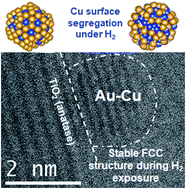Cu segregation in Au–Cu nanoparticles exposed to hydrogen atmospheric pressure: how is fcc symmetry maintained?†
Abstract
In a recent work [A. Nassereddine et al., Small 2021, 17, 2104571] we reported the atomic-scale structure and dynamics of sub-4 nm sized Au nanoparticles (NPs) supported on titania in H2 at atmospheric pressure obtained by using aberration-corrected environmental transmission electron microscopy (ETEM), density functional theory (DFT) optimizations and ab initio molecular dynamic (AIMD) simulations. Our results showed unstable Au NPs losing their face-centred cubic (fcc) symmetry (from fcc to non-fcc symmetries) and revealed the drastic effect of hydrogen adsorption. In this work, we use the same approach to study the dynamics of equiatomic Au–Cu NPs in the same range of size and the results show an enhanced structural stability upon alloying by Cu. In spite of the morphology evolution from facetted to rounded shapes, the observed Au–Cu NPs are found to keep their fcc symmetry under atmospheric hydrogen pressure. AIMD simulation evidences a Cu segregation process from the sub-surface toward the upper surface layer, and a reversed segregation of Au atoms from the surface towards the sub-surface sites. The analysis of the chemical ordering in the core shows a tendency to a local chemical ordering where Au–Cu hetero-atomic bindings are favoured. The segregating Cu seems to play a major role in reducing the fluxionality of Au–Cu NPs in H2 and thus, maintaining their fcc symmetry.

- This article is part of the themed collection: Nanoalloys: recent developments and future perspectives


 Please wait while we load your content...
Please wait while we load your content...